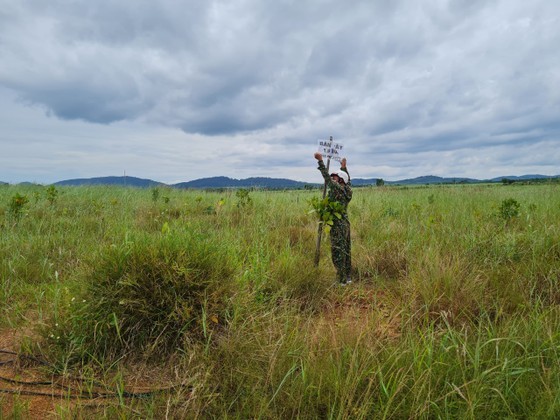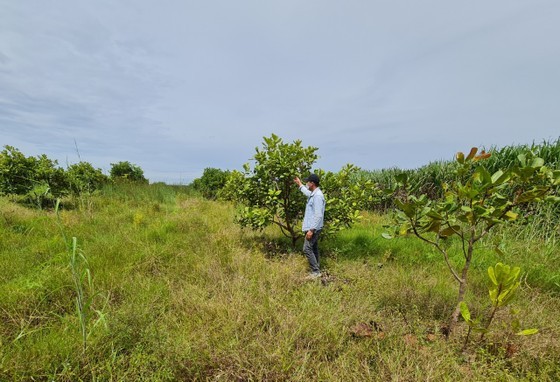 Forest land in Ea Bung Commune is put on sale publicly. (Photo: SGGP)
Forest land in Ea Bung Commune is put on sale publicly. (Photo: SGGP)
Meanwhile, most projects converted from forests operate inefficiently, resulting in the land continuing to be encroached on and the forest gradually dying while the authorities still struggle in handling violations and recovering forest land.
Ea Bung Commune in Ea Sup District in Dak Lak Province is one of the hot spots of land forest trading. The land is offered at VND150-200 million per hectare. However, because it is forest land, there is no red book, and land trading is only proved by handwritten documents. Through findings, in 2007, the People's Committee of Ea Sup District assigned 13 groups of households in Ea Bung Commune to manage and protect forests with an area of more than 1,735 hectares in sub-zones 245, 246, 252, and 259. The forest status at the time was exhausted forests with a density of 307 trees per hectare and a reserve of 8,000-24,000 cubic meters of timber. After 15 years, the forests in these sub-areas have now been deforested completely. There is no sign of a single natural forest tree, only rubber plantation, jackfruit orchards, and sugarcane fields stretching endlessly.
In Lam Dong Province, under the pressure of increasing demand for arable land and the trend of leaving the city for the forest, over the years, forest land has always been sought despite the risks that buyers may face. When we revealed our need to build a farm in the suburbs of Da Lat City with a tight budget, L.T.T., a real estate broker in Da Lat City and Lam Ha District, said that there is a plot of land that costs only VND220 million per 1,000 square meters, which is theoretically forest land, but people have grown coffee on it for many years. Therefore, we can buy it without worrying about being revoked. When we asked about the transfer procedures, L.T.T said firmly that there were only handwritten documents with fingerprints for assurance. If possible, we should grow some types of trees, such as macadamia, jackfruit, and durian, to create a green area for the forest and make it difficult for the land to be revoked.
The trading of forest land has taken place not only with State-managed land but also in projects allocated to enterprises. At the macadamia farm of Anh Sang Vinh Hoa Company, Mr. Tran Vinh, Director of the company, said that people occupied the forest land of more than one hectare belonged to the project and sold it to other people for VND150 million. After that, they even built houses illegally. The company has repeatedly called for help from the local government, but so far, the land is still occupied and even being sold to other people.
In Lam Dong Province, under the pressure of increasing demand for arable land and the trend of leaving the city for the forest, over the years, forest land has always been sought despite the risks that buyers may face. When we revealed our need to build a farm in the suburbs of Da Lat City with a tight budget, L.T.T., a real estate broker in Da Lat City and Lam Ha District, said that there is a plot of land that costs only VND220 million per 1,000 square meters, which is theoretically forest land, but people have grown coffee on it for many years. Therefore, we can buy it without worrying about being revoked. When we asked about the transfer procedures, L.T.T said firmly that there were only handwritten documents with fingerprints for assurance. If possible, we should grow some types of trees, such as macadamia, jackfruit, and durian, to create a green area for the forest and make it difficult for the land to be revoked.
The trading of forest land has taken place not only with State-managed land but also in projects allocated to enterprises. At the macadamia farm of Anh Sang Vinh Hoa Company, Mr. Tran Vinh, Director of the company, said that people occupied the forest land of more than one hectare belonged to the project and sold it to other people for VND150 million. After that, they even built houses illegally. The company has repeatedly called for help from the local government, but so far, the land is still occupied and even being sold to other people.
 Forest land in Lam Dong Province is traded secretly, causing difficulties for authorities. (Photo: SGGP)
Forest land in Lam Dong Province is traded secretly, causing difficulties for authorities. (Photo: SGGP)
In some areas near Da Lat City or neighboring districts, such as Lac Duong, Lam Ha, and Duc Trong, forest land is secretly traded from a few hundred million Vietnamese dongs to more than VND1 billion per 1,000 square meters, depending on the terrain, roads, and the most important factor - no forest around. According to land brokers, the supply and demand of the forest land market have increased sharply recently due to the influence of land fever. “The secret of forest land hunters is to turn forest land into vacant land that does not meet the criteria to become forests, and then turn them into stable arable land on forest land,” said a land broker in Lam Dong. Not only people but forest rangers also occupied forest land. Forest land was even changed into the land with a red book. This situation happened at the North Bien Ho Protection Forest Management Board in Gia Lai Province. Specifically, this management board failed to protect more than 2,471 hectares of forest land, of which many officials and employees of the management board occupied more than 84,000 square meters of forest land to build farms and houses. Among the encroached area, about 47,000 square meters have been illegally issued certificates of land-use rights by the People's Committee of Pleiku City, causing losses to the State. Regarding this incident, besides the responsibility of the Head of the North Bien Ho Protection Forest Management Board, several officials from the grassroots authorities to the Department of Natural Resources and Environment of Pleiku City and the Land Registration Office of Pleiku City are also responsible for failing to fulfill their roles in issuing land-use rights certificates.
 Forests in Gia Lam Commune in Lam Ha District are deforested for agricultural production. (Photo: SGGP)
Forests in Gia Lam Commune in Lam Ha District are deforested for agricultural production. (Photo: SGGP)
In Dak Lak Province, when we entered sub-zone 251 under the management of the July 27 Company to ask to buy land, a woman claiming to be the landowner met us. She said her name was Chau Thi Nhan. She was one of the major shareholders of the July 27 Company and owned more than 100 hectares of land in sub-zone 251. She offered a price of VND17 billion for more than 100 hectares. To build trust, Ms. Nhan also showed us that the above land had been granted cadastral extract and could make a red book. She said that she had contacts in the Department of Natural Resources and Environment of Dak Lak Province, and if we agreed to buy land, she would contact these people to make a red book for us. "For the land that has been granted cadastral extract, it is easy to make a red book, just spend about VND1 billion and wait for two months," she said. Not only that, but Nhan also revealed that the above land could be converted from forest land to agricultural land for about VND4 billion.
 Agricultural plantations in sub-zone 246 in Ea Bung Commune in Ea Sup District (Dak Lak Province) replace forests. (Photo: SGGP)
Agricultural plantations in sub-zone 246 in Ea Bung Commune in Ea Sup District (Dak Lak Province) replace forests. (Photo: SGGP)
The situation of converting forest land into land with a red book also happens a lot in Dak Nong Province. Many households in Dak Som Commune in Dak Glong District were sitting on pins and needles when the district People's Committee issued a notice to revoke red books because there was an overlap in the issuance of red books on the forest land. K'Hai, a resident of Dak Som Commune, said that his family has more than 2 hectares of coffee that have had its red book revoked. Most of the coffee areas were grown many years ago. There are coffee plantations that are nearly 20 years old now. There is no sign of the forest there. K'Hai also admitted that this area was a forest in the past. His family and many other households came to reclaim land for agricultural production. It was not until 2012 that the local authorities organized an inspection and issued land-use rights certificates to people in the area. Unfortunately, the land in the above area has already been planned as forest land, so it has to be recovered. Currently, the authorities of Dak Glong District are withdrawing 65 red books issued incorrectly in Dak Som Commune. However, the revocation of these red books faces many difficulties because most of the red books have already been mortgaged in banks for loans. Currently, Lam Dong Province has about 52,000 hectares of forest land, but it is under stable agricultural production, accounting for 8.7 percent of the province's total forest planning area. Of which, production forest planning is 34,916 ha, protection forest planning is 16,883 ha, and special-use forest planning is 242 ha.
























